I’m going to take a crack at this one not because I’m an expert at such things but because I have a bit of head forward syndrome myself, probably from spending a lot of hours per day in front of the computer writing. And I also happen to know that Timothy McCall addressed a similar years ago in his post Cultivating Healthy Posture with a Simple Restorative Pose.
In that post, he recommended practicing a restorative backbend pose to counteract poor posture (head forward syndrome qualifies as one form of that). He says that when we have a long-term habit of slouching, it may not just be as simple as to start sitting or standing up straight. Long-term slouching leads to shortening of muscles in the front of the upper body, as well as of the fascia, the connective tissue that surrounds and interpenetrates the muscles, and which can limit movement. And this is going to be true for head forward syndrome as well.
And because longer holds of poses are necessary to help lengthen the fascia, he believes staying in a pose for a few minutes may be ideal. Since that’s hard to do in most regular asana, particularly the backbends, which open up the back, he recommends a simple supported, passive backbend. I, myself, have been including these in my practice for about 15 years, after my yoga teacher recommended them for me in particular for my posture.
I also have some suggestions for how to strengthen your upper back and neck muscles, and to work mindfully on the alignment of your head and neck over your torso.
Stretching Your Front Body
Practice a simple passive backbend several times a week, for 3 minutes or more at a time. Because Baxter and I have included a simple passive backbend as one of our essential yoga poses, Melina shot some photos of Baxter doing the pose. So you can choose any of these three version that seems best to you. Make sure the one you choose is comfortable, so you can stay for three or more minutes without pain or discomfort.
One version shown here actually has the head higher than the torso and that probably won’t stretch your neck, but I remember that my father had head forward syndrome so severe that he couldn’t even lie with his head flat on the floor. So for some of you (or your students) it may be necessary to start with your head supported in these poses and gradually lower the support until you reach a point where you can be comfortable with your head even with and eventually lower than your torso.
If you can comfortably bend your neck back, this version would be a good one.
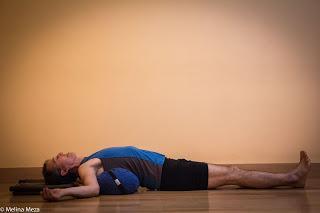 If you can't bend your neck back but you can lay it flat, you could do this version (or add more blankets to the first version)
If you can't bend your neck back but you can lay it flat, you could do this version (or add more blankets to the first version) If you can't even lay your head flat, you may need to prop your head up (though you can do that with more blankets in version 1 or 2).
If you can't even lay your head flat, you may need to prop your head up (though you can do that with more blankets in version 1 or 2). 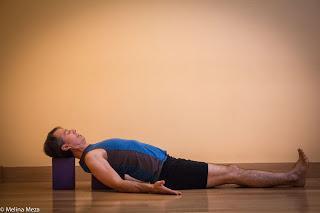 See Cultivating Healthy Posture with a Simple Restorative Pose for Timothy’s instructions on how to practice the pose (his suggested propping is a bit different)
See Cultivating Healthy Posture with a Simple Restorative Pose for Timothy’s instructions on how to practice the pose (his suggested propping is a bit different) Strengthening Your Back Body I would also add that strengthening your upper back and neck muscles would be beneficial because those can become weak from slouching. Regularly practicing Locust pose (Salabasana) would easily do the trick. Just be sure that when you lift your head in this pose not to cause strain by bending your neck back too far (this is especially true if you have head forward syndrome). Baxter's neck looks good to me in this pose.
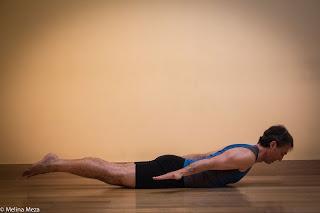 Mindfulness About Alignment
Mindfulness About Alignment Practicing Mountain pose (Tadasana) is a good way to cultivate awareness of your habitual posture and to move into a healthier alignment, where your head and neck are in line with your spine. Because your habit is going to feel more comfortable than a new alignment, have a partner or a teacher help adjust your head and neck in the pose.
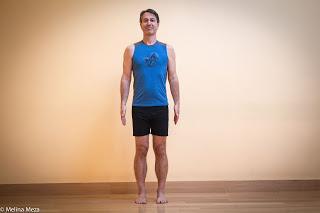
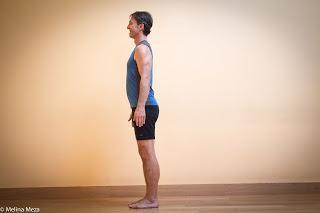 So practice this pose in the yoga room and then, when you’re out in the real world, take the new awareness you have to change your habitual posture while you’re working, standing around, or, yes, even texting. (Just because almost everyone texts by bending their necks to look down at the phone doesn’t mean you have to do it that way, too. See if you can find a way to prop it up on something higher.)
So practice this pose in the yoga room and then, when you’re out in the real world, take the new awareness you have to change your habitual posture while you’re working, standing around, or, yes, even texting. (Just because almost everyone texts by bending their necks to look down at the phone doesn’t mean you have to do it that way, too. See if you can find a way to prop it up on something higher.) I hope this helps, and would love to hear what you think after you've experimented with these ideas or if you have some other ideas.
—Nina
Subscribe to Yoga for Healthy Aging by Email ° Follow Yoga for Healthy Aging on Facebook ° Join this site with Google Friend Connect

